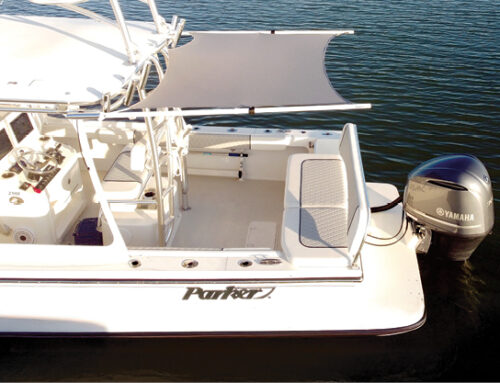Intelligent boat interiors
Updates to a boat’s interior design and upholstery provide boat owners the opportunity to easily express their individuality through their boat’s appearance. Options for creative expression have never been greater thanks to new colors, textures and patterns produced in high-performance fabrics.
Fabric trends
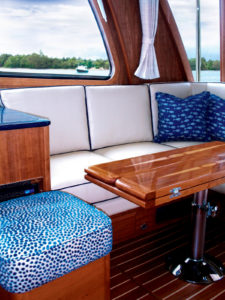
Traditional nautical colors are updated in this salon through the creative combination of colors and patterns. Photo: Onboard Interiors LLC.
Industry leaders point to fabrics with linen-like textures and bold colors and patterns as the latest trends in interior home design. According to Judy Bell-Davis, design director for the Bell Design Group Inc., Seattle, Wash., interior design trends for marine consumers are driven by the increasingly design-savvy public and reflect the home décor influences seen in architectural and lifestyle magazines and on television. American consumers, drawn to the value of performance fabrics typically found in marine applications, are asking for more personal, yet durable, upholstery and interiors.
Boat owners who want the look and feel of custom upholstery still need the performance characteristics of marine fabrics: easy to clean, resistant to mildew and mold and impervious to deterioration due to UV exposure. “Fabrics have to pass the performance characteristics required for it to be an outdoor fabric or else it will fade and won’t perform,” says Jim Ennis, president and CEO of J. Ennis Fabrics, Edmonton, Alberta, Canada. “New textures and bold colors, such as Tangerine Tango, the 2012 color of the year, are used in pillows, throws and welting.
Marine interior designers and fabricators incorporate these new trends by splashing texture and color against neutral backgrounds. For some, traditional navy cushions are judiciously updated by adding white or tan welting, and neutral cabin interiors are accented with warm orange or bronze pillows or drapes. For others, bright-colored fabrics are pieced together to create unique upholstery that reflects the boat owner’s individual style.
According to Bell-Davis, design is driven by the boat style’s demographic, so it’s more likely to find a tailored, sensible and efficient interior on a Nordic Tug, and a sleek Italian interior on a Sea Ray. Color choices, in general, trend differently in different regions as well as across different boat types: typically more conservative in the north and east than in the south and west; more colorful and patterned in sport boats and ski boats than large yachts.
Even so, new trends are easily introduced into the traditionally conservative marine markets such as in New England. “There are a lot of boats that have Captain Navy bimini tops or Captain Navy enclosures,” says Gina B. Wicker, design and creative director for Glen Raven Inc., makers of Sunbrella®. That doesn’t mean you have to use Captain Navy on the interior, but you might use a beautiful cool neutral in the gray family and have some navy piping on the cushions, or some small throw pillows scattered around the salon in a navy or a stripe that combine the navy and the gray.”
Katie Bradford, MFC, IFM, owner of Custom Marine Canvas, Noank, Conn., may introduce up-to-date colors by creating custom code-flag pillows. The pillows spell out the vessel’s name in accent colors, complementing the boat’s upholstery fabric.
Online for business
The abundance of design options available to the marine industry complicates the design process and can make sales time-consuming. Rather than shy away from the additional effort to ride design trends, designers and fabricators use computers, smart phones, software programs and electronic measuring instruments in innovative ways to streamline all phases of their work.
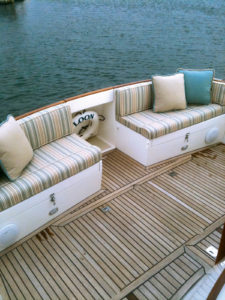
Traditional neutrals are updated by combining them with accent colors in the striped cushion fabric. The throw pillows highlight the accent colors from the cushions.
Computers and the internet, once used exclusively for business applications, like accounting and correspondence, are being used to facilitate marine upholstery design, enhance communication with customers during the design and sales phase, and improve efficiency during the fabrication process. The time-saving, precision-enhancing and profit-generating characteristics of digital tools drive the high-tech migration into the marine upholstery industry.
Krisha Plauché, principle designer for Onboard Interiors LLC, Marblehead, Mass., has increased the portion of her work done via the internet. During the initial project definition and sales processes, Plauché emails photos of finished projects to her customers and fine tunes all the project details with them through email correspondence. Using technology in this way saves time previously spent traveling to and from boats and in face-to-face meetings. Plauché says it also improves customer service since using email cuts the time necessary to respond to customer queries. Design plans, photos and estimates can be relayed at any time, while face-to-face meetings are restricted to business hours.
Another advantage of using the internet is to connect to the online catalogues of fabric mills and suppliers. Plauché’s customers can see which fabrics she’s proposed for their project. Plauché then checks the fabric’s availability online and secures the quantity needed the moment the customer approves the project. It’s been especially advantageous during the recession since customers may approve an entire project, but decide to implement only part of it immediately. By using the online services, Plauché can guarantee her customer that the fabric will be available for the entire project.
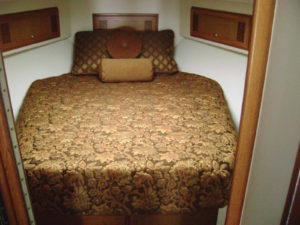
Customers increasingly request memory foam mattresses in response to advertising and its use in home furniture. Katie Bradford of Custom Marine Canvas created this V-berth mattress by laminating 2-inch-thick memory foam to the top of 3-inch-thick SR35 foam. The rich fabric used in the bedcover adds texture to the neutral palette, and still provides all the performance characteristics of marine fabrics. Photo: Custom Marine Canvas.
Fabricators across the country have established a web presence by creating their own websites, taking steps to enhance their site’ search engine ranking, and loading the site with before and after photos and glamour shots of finished projects. Potential customers find out about websites, either from traditional advertising or online search engines, check the pictures and then contact the fabricator.
When customers use the website, then all parties can be sure they are talking about the same thing, which eliminates misunderstanding and miscommunication.
Mike Charpentier, Paul’s Custom Canvas, Broomfield, Colo., says the company’s website gives his customers, who are looking for brighter colors and striking patterns, sources of inspiration for their own projects. Digital photos, when loaded onto a laptop or iPad, are sales tools. The hardware is lightweight, easy to take to the boat to show examples of finished work and fabric samples. “People are even using iPads to get a signed contract,” Bradford says. “You can take a credit card with it.”
Rebecca Kennedy, designer and co-owner of Kennedy Custom Upholstery, Ocean City, N.J., goes one step further and has an online estimate request capability. Customers send detailed information directly to Kennedy’s email inbox, which helps to streamline the process and make it possible to work out all the details of a project with clients living out of the area. The boat owner is apprised of the project’s progress every step of the way, even if they don’t actually see the results in person. When the project is finished, Kennedy emails photos along with the final invoice.
Digital tools and equipment
More complex and expensive digital technologies are generally adopted by fabricators on more of a for-project basis rather than just by the size of the fabricator’s operation. Bradford uses photo-imaging software to create virtual interior structures for boats still under construction, but she uses Canvex and her specially crafted “bevelometer” (an adjustable T-square to measure the bevels in the hull) to create upholstery patterns for boats that already exist. Kennedy uses a CAD (computer-aided design) program to strategically lay out cutting patterns for upholstery before putting scissors to the fabric.

This interior by Paul’s Custom Canvas demonstrates the bright colors and intricate patterns found more typically in sport boats and in the central parts of the country. Photo: Paul’s Custom Canvas.
Perhaps the best-known design technology is computer-assisted drawing. The design is worked entirely on a computer. The program can create a PDF file to be printed on regular-sized paper or full-scale patterns to be used for cutting fabric. It can also create a digital file that is sent to a computerized cutting table or shared with other people involved in the design and production process.
Typically used for large-scale projects, Kennedy uses CAD when designing interiors. She plots the pattern pieces in CAD, uses the program to find the most efficient layout, and then takes the resulting diagram to the cutting table. “It’s just a blueprint,” Kennedy says. “We make all the mistakes on the computer, where there’s no consequence, instead of on the fabric.”
It’s not necessary to use the digital tools when simpler craft-techniques are appropriate. Bell-Davis, frequently working in areas without internet access, sketches various ideas with a pad and pencil while talking through design ideas with her customers. In larger-scale projects, Bell-Davis works with an IT specialist to translate her drawings into digital files. Then various production departments can easily share the design files. The choice of which technology to use depends on the project.
Mike Erickson, MFC, owner of Mike Erickson, MFC, owner of Canvas Designers Inc., Riviera Beach, Fla., is one of the first marine fabricators to adopt the Prodim Proliner.Proliner is a portable digital measuring tool that can create digital files in 2-D and 3-D.
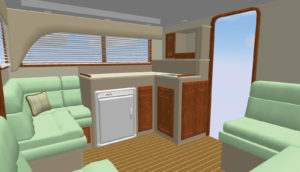
A salon model from the marine version of Awning Composer that is currently being developed. Fabrics selected from the online library will populate this screen, enabling the fabricator and their customer to preview various colors and color combinations. Photo: Tri Vantage.
Erickson found the most effective way to create patterns doesn’t necessarily require taking the Proliner to the customer’s boat. Rather, his crews take patterns using traditional materials and methods on the boat. The patterns are digitized in the shop, using the Proliner’s 2-D capability. The resulting digital file can be sent directly to a computerized cutting table. The 3-D capability is used when the complexity of the project requires the need to work with the 3-D files.
There are costs involved when introducing new technologies into an established design and fabrication process, including time to research the technology appropriate for the project, the cost of the actual equipment and software, and time to become comfortable with the technology.
New technologies should be added incrementally to ensure successful adoption. Start with something familiar, like the shop’s computer, for example, and begin adding one thing at a time: a website, digital photos, links to fabric mills catalogues. Additional digital tools, such as plotter/cutters and CAD software, can be incorporated into the production process as needed.
Many marine fabricators are becoming confident and savvy with these technologies and are using them to create the best end products for their customers.
Mary Jo Morris is the former owner and operator of Berkeley Marine Canvas in Berkeley, Calif. She and her husband, Jim, live in Point Richmond, Calif., and sail on San Francisco Bay.
 TEXTILES.ORG
TEXTILES.ORG 


